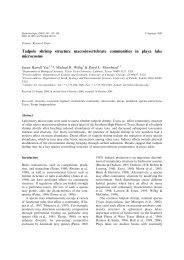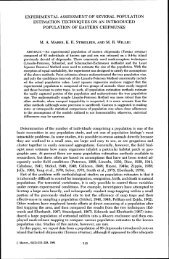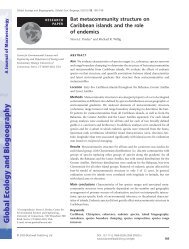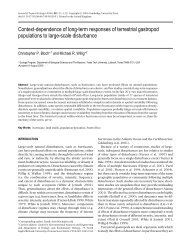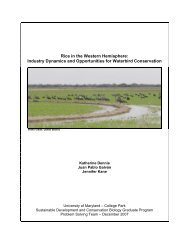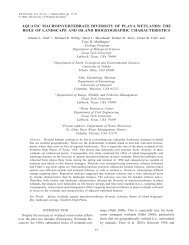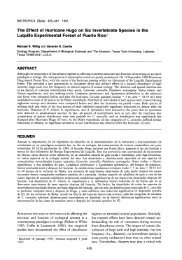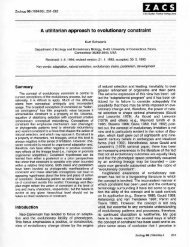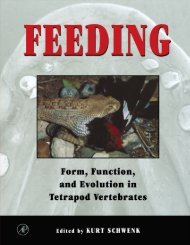Comparative biology and the importance of cladistic classification: a ...
Comparative biology and the importance of cladistic classification: a ...
Comparative biology and the importance of cladistic classification: a ...
You also want an ePaper? Increase the reach of your titles
YUMPU automatically turns print PDFs into web optimized ePapers that Google loves.
70 K. SCHWENK<br />
It is obvious that groups held to be equal or dichotomous on <strong>the</strong> basis <strong>of</strong> <strong>classification</strong><br />
may not have had an equal extent <strong>of</strong> geologic history, <strong>and</strong> when it is intended to<br />
illustrate this history simultaneously with <strong>the</strong> <strong>classification</strong> some difficulties present<br />
<strong>the</strong>mselves. [Camp, 1923: 3361.<br />
INTRODUCTION<br />
Systematic <strong>biology</strong>, in its narrow sense, has three overlapping charges: <strong>the</strong><br />
naming <strong>of</strong> species, <strong>the</strong>ir <strong>classification</strong>, <strong>and</strong> <strong>the</strong> reconstruction <strong>of</strong> <strong>the</strong>ir<br />
phylogenies. The first <strong>of</strong> <strong>the</strong>se pursuits is little changed since Linnaeus, but <strong>the</strong><br />
manner in which <strong>the</strong> latter two are undertaken depends on <strong>the</strong> school <strong>of</strong> thought<br />
to which an investigator adheres: phenetics, evolutionary taxonomy or <strong>cladistic</strong>s<br />
(e.g. Wiley, 1981; Ridley, 1986; Mayr & Ashlock, 1991). These have been<br />
admirably reviewed by <strong>the</strong>se authors <strong>and</strong> o<strong>the</strong>rs, <strong>and</strong> it is not <strong>the</strong> purpose <strong>of</strong> this<br />
paper to discuss <strong>the</strong>ir various merits <strong>and</strong> deficiencies. Ra<strong>the</strong>r, I focus on,<br />
perhaps, <strong>the</strong> most contentious aspect <strong>of</strong> <strong>the</strong> controversy, namely criteria on<br />
which we base organismal <strong>classification</strong>s in light <strong>of</strong> recovered phylogenies.<br />
Purely phenetic <strong>classification</strong> has fallen into ill favour among most systematists<br />
owing largely to its failure to differentiate among similarity stemming from<br />
convergence, similarity stemming from retention <strong>of</strong> ancestral attributes, <strong>and</strong><br />
similarity stemming from shared evolutionary novelty uniquely evolved in a<br />
common ancester (homoplasy, symplesiomorphy <strong>and</strong> synapomorphy,<br />
respectively, in <strong>cladistic</strong> parlance). Arguably, <strong>the</strong> greatest contribution <strong>of</strong><br />
<strong>cladistic</strong>s is its recognition that phylogeny can only be inferred from<br />
synapomorphy (e.g. Wiley el al., 1991). Early evolutionary taxonomists used a<br />
more informal method <strong>of</strong> phylogeny reconstruction that did not explicitly<br />
exclude symplesiomorphy (e.g. Simpson, 1945) ; however, recent workers have<br />
accepted <strong>the</strong> central role <strong>of</strong> synapomorphy in phylogenetic inference (e.g. Mayr,<br />
198 1). Therefore, in <strong>the</strong>ir current incarnations, <strong>the</strong> schools <strong>of</strong> evolutionary<br />
taxonomy <strong>and</strong> <strong>cladistic</strong>s (sensu Hennig, 1966) differ little or not at all in <strong>the</strong> way<br />
in which species are named <strong>and</strong> phylogenies reconstructed. However, when<br />
constructing a <strong>classification</strong> based on a phylogeny so-inferred, <strong>the</strong>y may be at<br />
odds in <strong>the</strong>ir choice <strong>of</strong> criteria on which to base supraspecific taxa.<br />
Cladists argue that <strong>classification</strong>s <strong>and</strong> named taxa should reflect evolutionary<br />
entities <strong>and</strong> <strong>the</strong>refore rely only on <strong>the</strong> branching pattern <strong>of</strong> <strong>the</strong> phylogeny. Every<br />
named taxon will, <strong>the</strong>refore, be monophyletic. All o<strong>the</strong>r aspects <strong>of</strong> phenotypic<br />
evolution, such as rate <strong>and</strong> degree <strong>of</strong> divergence from a common ancestor, while<br />
interesting, are <strong>of</strong> secondary <strong>importance</strong> (Ridley, 1986). This convention allows<br />
any investigator to extract accurate information about a phylogeny from <strong>the</strong><br />
<strong>classification</strong>. In contrast, evolutionary taxonomists such as Mayr ( 1974, 1981)<br />
<strong>and</strong> Mayr & Ashlock (1991) believe that a <strong>classification</strong> should contain<br />
information in addition to <strong>the</strong> branching pattern <strong>of</strong> phylogeny. They might<br />
emphasize some aspect <strong>of</strong> phenotypic evolution, usually <strong>the</strong> relative degree <strong>of</strong><br />
morphological divergence among lineages, by formally recognizing a<br />
paraphyletic taxon (a lineage containing an ancestor <strong>and</strong> some, but not all <strong>of</strong> its<br />
descendants). The classic example <strong>of</strong> this practice <strong>and</strong> its difference from<br />
<strong>cladistic</strong> <strong>classification</strong> is <strong>the</strong> treatment <strong>of</strong> birds <strong>and</strong> reptiles (Fig. 1). The<br />
evolutionary taxonomist’s notion <strong>of</strong> a reptile excludes birds because birds, have,<br />
in <strong>the</strong>ir view, diverged so radically from conventional reptiles (e.g. <strong>the</strong>y have



